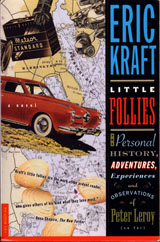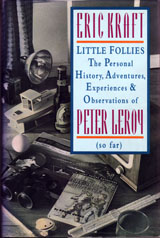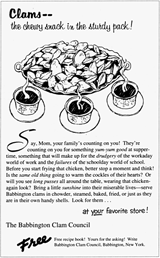

| Little Follies
My Mother Takes a Tumble Preface: Milestones on the Map of Memory |
by Eric
Kraft, as Peter
Leroy
|

YOU CAN READ THE FIRST HALF
YOU CAN ORDER THE
|
In the years that followed her tumble, if talk around the dinner table turned to Mr. Beaker, a former neighbor, my mother would often ask, wistfully, I thought, “Do you remember the night he threw his desk lamp through the window? When was that?” Someone else, usually my grandmother, would answer, “Why, Ella, don’t you remember? It was the day you fell out of your lawn chair.” It is comforting, when one feels a bit “lost,” to be able to put one’s feet up, close one’s eyes, and look back, as it were, along the road that one followed from wherever one once was to wherever one may be now, to “retrace one’s steps,” and find, along that roadside, familiar milestones. It is certainly comforting for me; for if I am feeling a bit “lost,” when I begin such a backward ramble, I am often lost during it as well, wandering on someone else’s road, or backing out of a cul-de-sac, and it is always a great relief to come upon one of these milestones, or, if you prefer, landmarks. It is a particularly great relief if I stumble upon the milestone that marks the day that, for the rest of my family, came to be known as “The Day Ella Tumbled from Her Lawn Chair” and is, on the map of my childhood memory, labeled “The Day I Was Chasing Kittens,” for it is from that day that I date all the rest. However, I began writing “My Mother Takes a Tumble” not with the aim of commemorating that event but to find a woman for Mr. Beaker. When I was a child on No Bridge Road, living with my parents in my grandparents’ house, Mr. Beaker lived next door, alone. I knew very little about him, and as far as I can recall I never set foot inside his house. He visited my grandparents from time to time, and he always stayed just a little too long. He worked for the Babbington Clam Council, writing advertisements. Later, I think, he became president of the council; I’m not certain. He considered himself a fine craftsman with an uncanny knack of echoing, in each of his advertisements, the tone, style, and yearnings of potential clam consumers. |
 |
||||
 |
Mr. Beaker relished his work and labored at it longer
and harder than was really necessary, often working at home well into the
night, when there were fewer distractions and his vast unseen audience
seemed to draw in around him, like a group around a campfire, and lean
forward, waiting for him to spin a yarn about the succulent mollusk.
Between his house and my grandparents’ grew a young oak that never fully
lost its leaves until the very end of winter; when Mr. Beaker was at work
at night, when I was in my crib, the light from his desk lamp would throw
the shadows of its branches across my crib, across my parents’ bed, and
onto the opposite wall, where a door opened into a hall that led into the
living room, where Gumma and Guppa and my parents sat listening to the
radio or talking, quietly and uneasily, for living together was difficult
for all of them.
Whenever Mr. Beaker was visiting and the time had come for him to go home, his face would grow long and dark, and he would begin praising my grandmother’s cooking and my mother’s figure. “Dudley,” my father would say after he had left, “needs a woman.” Years later, I was walking along one fall day and smelled the unmistakable odor of burning leaves. It brought to mind, for reasons I will explain shortly, the years I spent on No Bridge Road, and Mr. Beaker, and all the rest, ending with my father’s saying, “Dudley needs a woman.” I realized that my father had been right, and that Mr. Beaker had thrown his desk lamp through the window that night because he was alone and hated it; so I created Eliza Foote, arranged a meeting, and let events take their natural course. Some readers will be interested in knowing the sources of one or two other fabricated details. My grandfather, Guppa, is a Studebaker salesman in “My Mother Takes a Tumble.” In fact, he was not. Making him a Studebaker salesman was, I admit, simply an easy way out of a difficult situation. Let me explain. The smell of burning leaves made me recall my years on No Bridge Road because it brought to mind quite clearly a fall ritual that began with the raking and burning of leaves: as if in response to some silent bell, men up and down No Bridge Road would rise from their breakfasts one fall Saturday, pull on old sweaters, step outside with rakes in their hands, and begin raking leaves into enormous piles on their lawns. Then the children of the neighborhood would jump into these huge piles, run through them, and scatter them. (At that time, any decent leaf pile came up to my waist, and in some I could get buried up to my armpits, but today I am hard pressed to accumulate a pile that reaches to my knees. Either there are fewer leaves now than there were then, or the art of piling leaves has decayed.) The men would rake the leaves into piles again and then begin carrying them to the street. They would make a number of small piles in the street, in the gutter, which was merely a shallow valley at the margin of the roadway, not defined by a curbstone, and burn them, one pile at a time. Up and down No Bridge Road, men would lean on rakes and watch their leaves burn. The burning of leaves was followed by the second part of the ritual: the crushing of shells. Everyone on No Bridge Road had a clamshell driveway; many people in Babbington still have clamshell driveways, but they are not so widely favored now as they once were. They were cheap and serviceable, and required little maintenance other than a yearly addition of new shells to replace the bits of crushed shell that had been carried away by the wheels of cars and bicycles or the soles of the mailman’s, milkman’s, and breadman’s shoes or washed into the gutter in rainstorms. The men would drag out burlap sacks of clamshells that had accumulated since the last fall and dump them onto their driveways. The children would pick through the shells and set aside a few of the shapeliest, the most clamshell-like; these paragons would be used for ashtrays or made into knickknacks. The others, the not-quite-right, the deformed and broken, the men would spread up and down the driveways. Then, and at last we near the point of this reminiscence, they would drive their cars up and down the driveways to crush the shells. So vividly did the smell of leaf smoke return the memory of those fall days to me that I could see all the men driving up and down their driveways and hear the clamshells crushing under their wheels. Quite suddenly, I realized something that had never struck me when I witnessed this scene as a child. All the men were driving Studebakers. I looked more closely, straining to see all the way to the corner. There was no doubt about it: every car on No Bridge Road was a Studebaker. This put me into quite a tizzy, because I knew that if I included this remarkable fact without explanation the reader would regard it as gratuitously absurd. So, to make it plausible, I made Guppa a Studebaker salesman, and a very good one, although in fact he was a foreman in the culling section of the clam-packing plant. In the barroom scene, I have repeated the word barroom far too often, I know. I have no excuse; I repeated the word simply because I enjoy coming upon it when I read, for I cannot help reading it, no matter how strong the context, as the word my childhood chum Raskol used to use to imitate the sound of a mighty explosion: “Boy! You should’ve seen it when old Roundass’s clamboat got hit by lightning. He’s right in the middle of the bay, minding his own business, taking a break to wipe his sweaty brow, and thinking that maybe he’ll eat a sandwich, when suddenly there’s a big flash of light, and then barroom!” One more point. In “My Mother Takes a Tumble,” all the houses on No Bridge Road are stucco. (That is, they are faced with stucco. Such houses are in Babbington called simply “stucco” instead of “faced with stucco.”) That was not actually the case. All the houses on the north side of No Bridge Road were stucco, but on the south side was a hodgepodge of small vacation houses and shacks, unevenly spaced and poorly painted, with no garages and, as I recall, no Studebakers, despite the efforts of my grandfather. I omitted any mention of the differences between the two sides of the street because I knew that if I mentioned the difference I would have to explain it, since if I did not explain it, many readers would consider my not explaining it significant, nodding knowingly and saying to themselves, sardonically, as Porky White did when I tried it out on him, “I see what this is. It’s all class differences. Peter is born into the tight-assed and striving lower middle class, a class that literally lives behind a thin and fragile facade: stucco.” He put his fork down and took a swallow of coffee. “You know,” he said, “the lower middle class is very interesting, if pitiable. This facade they work so hard to erect and maintain is, well, it’s like the frosting on this cake.” He poked with his fork at the slice of cake I had given him. “It’s pretty white frosting, but it has no real flavor; it’s just sweet. The good part of the cake, in fact the essence of cakeness, is the cake itself: its texture, its chocolaty-good flavor, even its shape. So the people in the class into which Peter is born, to sum up, are hiding their true vital essence, their essential vitality, behind a sort of icing. Ahhhh —” He waved his fork at me. “— but across the street Peter sees, and maybe yearns to join, the haphazard, sweaty, lusty, and fundamentally richer life of the unfrosted sometimes-working class. Right?” Peter Leroy
|

Babbington Clam Council
|
||||
| ..... | .......... | .......... | ..... |

Here are a couple of swell ideas from Eric Kraft's vivacious publicist, Candi Lee Manning: Tip the author.
Add yourself to our e-mailing list.
|
Little Follies is a work of fiction. The characters, incidents, dialogues, settings, and businesses portrayed in it are products of the author’s imagination and are not to be construed as real. Any resemblance to actual events or persons, living or dead, is entirely coincidental. All rights reserved. No part of this book may be reproduced or transmitted in any form or by any means, electronic or mechanical, including photocopying, recording, or by any information storage and retrieval system, without permission in writing from the author. “My Mother Takes a Tumble,” “Do Clams Bite?,” “Life on the Bolotomy,” “The Static of the Spheres,” “The Fox and the Clam,” “The Girl with the White Fur Muff,” “Take the Long Way Home,” and “Call Me Larry” were originally published in paperback by Apple-Wood Books. Little Follies was first published in hardcover by Crown Publishers, Inc., 201 East 50th Street, New York, New York 10022. Member of the Crown Publishing Group. YOU CAN ORDER THE
For information about publication rights outside the U. S. A., audio rights, serial rights, screen rights, and so on, e-mail the author’s imaginary agent, Alec “Nick” Rafter. The illustration at the top of the page is an adaptation of an illustration by Stewart Rouse that first appeared on the cover of the August 1931 issue of Modern Mechanics and Inventions. The boy at the controls of the aerocycle doesn’t particularly resemble Peter Leroy—except, perhaps, for the smile. |
ABOUT
THE PERSONAL HISTORY
LITTLE
FOLLIES
|
||||||
| . | . |